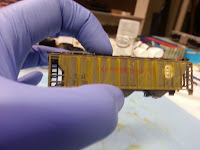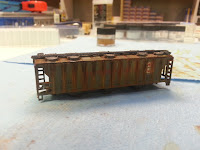
I have been spending a lot of time with a soldering iron in hand building turnouts and laying the track to finish our Jefferson City Yard.
This morning I added the last two pieces of track for the yard! the track work in the yard is complete. Spent part of the day running locos with strings of cars over areas that have power already and cleaned up an difficult spots. Now just a whole lot of track feeders, a couple dozen Tortoise switch machine installs, the yard diagram featuring manual throws for the Tortoises for more efficient switching, more ties added, ballasting..... at least as of right now I have the mainline and 3 yard tracks that I can use to entertain myself.
Also I started on the yard layout board, diagram, switch controls, today. I am building it on a 1/8" x 24" x 8" piece of plastic. The plastic had been purchased awhile ago for cnc milling and it was still around so...
I printed out the design for it in full scale across three sheets of paper and then worked from that adding artist tape to the plastic where the track lines would be. The plastic is naturally white, somewhat translucent, so once the track marks were down with artist tape it got a layer of black paint, tape was pulled, and then a couple coats of polycrylic to protect the paint from being torn up as easily.
All spots that represent a turnout have been drilled out to accept mini DPDT switches and then 3mm bipolar Red/Green LEDS have been added just beyond the switch to indicate which way the switch is aligned. The is a whole lot of wiring to go on this project and its going to be a little bit of a nightmare. Each DPDT switch will have 12v input and then have 12v output to the Tortoise, and also have to go through a 380ohm 1/4w resister to provide power for the LED indicator. I've decided on fabricating resistor circuit board to help clean up the wiring a little, but as you can imagine, its a whole lot more soldering coming my way.
All spots that represent a turnout have been drilled out to accept mini DPDT switches and then 3mm bipolar Red/Green LEDS have been added just beyond the switch to indicate which way the switch is aligned. The is a whole lot of wiring to go on this project and its going to be a little bit of a nightmare. Each DPDT switch will have 12v input and then have 12v output to the Tortoise, and also have to go through a 380ohm 1/4w resister to provide power for the LED indicator. I've decided on fabricating resistor circuit board to help clean up the wiring a little, but as you can imagine, its a whole lot more soldering coming my way.
















